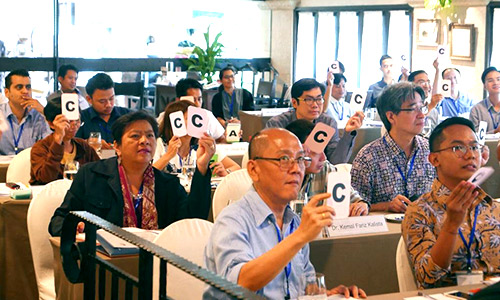TREAT Asia Conducts Physician Training on HIV and Hepatitis C Co-infection Treatment
In May 2016, 34 primary care and infectious disease physicians, patients, and treatment access advocates from six countries in South and Southeast Asia met in Bangkok for a one-and-a-half-day training on treating hepatitis C and HIV co-infection with the second-generation direct-acting antivirals (DAAs). The objective was to build the skills of clinicians in using DAAs and to share recommendations from the World Health Organization (WHO) and various professional liver societies. TREAT Asia conducted the training in collaboration with the International Network for Hepatitis in Substance Users (INHSU) and the Australasian Society for HIV, Viral Hepatitis and Sexual Health Medicine (ASHM).

In the Asia-Pacific region, about 87 million people are infected with hepatitis C,1 including more than half a million who are co-infected with HIV.2 DAAs are more effective and safer than previously used drugs and are now recommended as first-line treatment by the WHO, which in April 2016 updated its guidelines for hepatitis C screening, care, and treatment. However, barriers to accessing DAAs persist for a number of reasons. Many countries do not have government-funded testing and treatment programs and/or have not yet registered the drugs for use. In addition, most middle-income countries in Asia do not benefit from the price reductions that have been made available through special programs to low-income countries, so the drugs remain too expensive for many people who need them.
“TREAT Asia believes that given the large number of patients with hepatitis C in the region, we have to prepare infectious disease and primary care physicians who already treat HIV patients to use DAAs in the future” said Giten Khwairakpam, TREAT Asia’s project manager for community and policy.
The agenda included understanding steps for diagnosing hepatitis C infection, staging liver disease, managing side effects, and reviewing clinical care and treatment responses among people who inject drugs. Participants were also presented with real-life case studies of those who have been treated with DAAs in resource-poor settings.
“Training to build the skill set of clinicians who directly interface with people having HIV and hepatitis C co-infection is much needed in the Asia-Pacific region,” said Dr. Gail Matthews, Associate Professor at the Kirby Institute in Sydney, Australia, who led the training. “As well as empowering the participants to better treat their patients, this session can serve as a model for larger-scale training efforts in the region.”
“Physicians who attended the training said it made them feel more confident about providing better care to their patients co-infected with HIV and HCV,” added Mr. Khwairakpam.
TREAT Asia has played a major role in working to improve access to DAAs. In addition to hosting regional consultations for advocates to coordinate their efforts to influence government policies and improve access to screening and care, it is developing educational materials for both patients and medical providers on the use of DAAs.
1 Walsh N, Durier N, Khwairakpam G, Sohn AH, Lo YR. The hepatitis C treatment revolution: how to avoid Asia missing out. Journal of Virus Eradication 2015; 1:272-275.
2 Platt L, Easterbrook P, Gower E, McDonald B, Sabin K, McGowan C, Yanny I, Razavi H, Vickerman P. Prevalence and burden of HCV co-infection in people living with HIV: a global systematic review and meta-analysis. Lancet Infectious Diseases 2016 Feb 24. [Epub ahead of print]
Share This:
